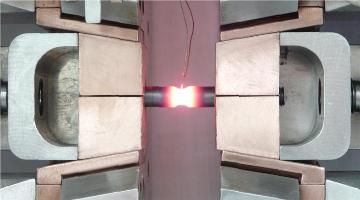High strength steel is a boon for the machine construction and automotive industries in their quest for light weight materials for building bridges, roofs and cars. However, the lightweight, high tensile strength steel is marred by its vulnerability to cold cracking on welding.
 Material sample being heated to welding temperature to determine its critical conditions for the formation of cold cracking
Material sample being heated to welding temperature to determine its critical conditions for the formation of cold cracking
The cracks which are extremely tiny fractures, appear when the welded joints start to cool below temperatures of 200 °C. The worst possibility is the development of cracks at the welded seams. Owing to this characteristic and the difficulty in predicting the formation of cracks, the high strength steel is not readily employed inspite of its other superior properties. Researchers at the Fraunhofer Institute for Mechanics of Materials (IWM) have collaborated with the Joining and Welding Technology Chair at Brandenburg University of Technology Cottbus to overcome this limitation of high strength steel by engineering a process to calculate the probability of cold crack formation in the design stage itself and to even incorporate corrective measures.
Earlier methods of testing high strength steel involved time consuming, expensive procedures such as subjecting the material to high tensile stresses and determining the stress level that results in cracking. Another disadvantage of this method is that the test findings are not applicable to ensuing components due to differences in geometry. Computer simulations have also been found lacking in providing accurate predictions. The new method takes into consideration, factors such as hydrogen concentration in the steel, microstructure configuration, nature of residual stress and temperature gradients resulting from welding. A computer simulation with these factors as inputs yields the areas of materials of random geometries at risk of cold cracking. The new process not only reduces cost but also quickens development.